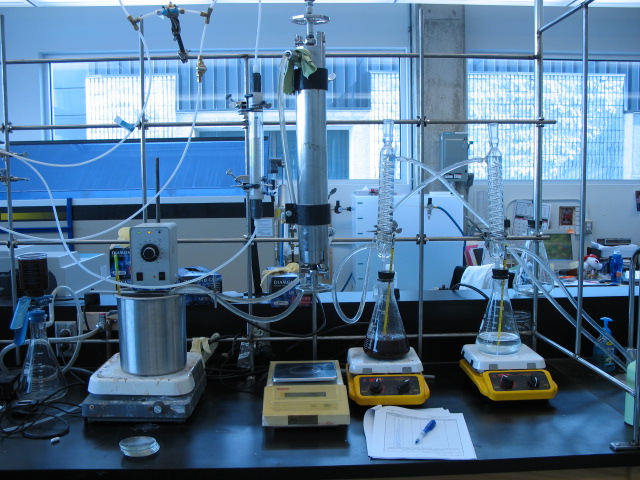LABORATORY TESTS

PHASE AND COMPONENT ANALYSIS
ANALYTICAL EXPERTISE AT THE SERVICE OF PROCESS ENGINEERING
For the purpose of our design and troubleshooting projects, we often have to characterize different phases or components from complex matrices. These mixes are often made up of different material coming from a range of separation process devices.
Being able to target the right analysis and to correctly interpret the data requires a vast knowledge of industrial processes and of existing analytical methods. STS Canada is composed of engineers and technicians that sum up great experience in these matters. We are therefore able to provide quick, reliable and efficient solutions to our clients. We have state-of-the-art laboratories at our disposal where we can perform a vast range of analytical investigations.
Here is a quick look at some of the available analyses for aqueous or organic phases. This list is not exhaustive. Please contact us for more information:
- Acidity (reported as CaCO3)
- ammoniacal nitrogen
- BOD5
- Chlorinated aliphatic hydrocarbons
- COD
- Conductivity
- Cyanides
- Fluorides
- Monocyclic aromatic hydrocarbon
- PCB (polychlorinated biphenyl)
- Percentage of components (atomic absorption GCMS)
- Petroleum hydrocarbon (C10 - C50)
- pH
- Polycyclic aromatic hydrocarbons
- Total coliforms
- Total dissolved solids
- Total hardness by ICP
- Total Kjeldahl nitrogen
- Total oil and grease
- Total phosphorus
- Total sulfates
- Total suspended solids
- Total volatile matter
- Viscometry
- Angle of repose
- Bulk density
- Conventional dry sieving
- Elemental analysis by X-ray fluorescence
- Laser particle size distribution
- Nature of component by X-ray diffraction
- Nature of component by Electron Micro Probe (EMP)
- Solids Geometric structure determination using Scanning electron microscopy
- Specific gravity
- X-ray diffraction
- X-ray fluorescence
- Acid dew point
- Determination of deduster inlet gas load
- Determination of main gas components
- Dew point
- Gas Flow
- Stack emissions
- Air permeability
- Air permeability plot of fluidization fabrics
- Basis weight (surface mass)
- Canvas type (polymer)
- Canvas type (structure)
- Canvas weight
- Chemical resistance testing
- Deduster simulation
- Differential scanning calorimetric analysis
- Fiber diameter
- Fiber surface state determination by scanning electron microscopy (SEM)
- Fiber type determination
- Flame resistance
- Heat induced dimensional change
- Infrared spectrum
- Light microscopy
- Limiting oxygen index (LOI)
- Linear Density of yarn
- MIT Folding endurance test
- Molecular weight determination
- Mullen test
- Multipass filtration testing
- Non-fibrous component
- Organic content
- Porosity by bubble point
- Resistance to abrasion
- Restriction determination by scanning electron microscopy (SEM)
- Single strand Yarn Tensile strenght
- Surface bonding strength (weft and warp, filling)
- Thermogravimetric analysis (TGA)
- Thickness
- Water permeability
- Water repellency
- Weft and Warp yarn count
- Yarn type (polymer)
- Yarn type (structure)
- Component analysis (yarn, couplers, rings, resin, splices)
- Confection details (seam inspection, filter tube/filter bag width and lenght measurements)
- Visual inspection of filtering elements' components (with pictures)

CONSTANT CALCULATIONS FOR DESIGN AND OPTIMIZATION
SIMULATE TO VALIDATE
Among the many filtration and separation processes available on the market, choosing the right device or system, while being a crucial step, can be a bit overwhelming.
Over the past 15 years, STS Canada has been building and using simulators and designing lab protocols. These testings enable us to calculate necessary constants for system and unit operation design. Only with this kind of understanding of separation processes, can the highest benefit-to cost ratio be achieved. You can count on us for the design and optimization of your separation processes:
Pilot lab equipment enables us to exhaustively demonstrate the technical and economical validity of our recommendations. With the constants generated through our experimentations we are then able to size your equipment with great precision. This in turn garantees a robust operation that meets your objectives. Below is an overview of our simulating capabilities:
- Pressure filters (pocket leaf filter, candle filter)
- Vacuum filter
- On-line strainer
- Membrane filtration
- Settling rate testing (jar tests)
- Hydrocyclone
- Centrifugal separator
- Dissolved-air flottation
- Electrocoagulation
- Liquid-liquid separator
Our thorough comprehension of filtration principles enables us to target key parameters and constants to be evaluated through our lab testings and simulations. For instance:
- Volume and mass resistance
- Permeability
- Porosity
- Moisture content
- Dry and wet bulk density
- Washing pattern plot
- Optimum washing ratio
- Cake moisture dewatering plot
- Optimum pressure and drying time
Sometimes filtration objectives can not be reached without oversizing equipment. To avoid such expenditures, STS can evaluate different cake property modifiers which could facilitate filtration and circumvent the need for bigger and more expensive systems.
The most popular techniques and products can be summarized as:
- Liquid coagulant
- Solid coagulant
- Natural flocculants
- Synthetic flocculants
- Solid filter-aids
- Surface active agents (moiture control surfactant)
- Cell disruption techniques (Lysis)
When chemical species to be separated are in a dissolved state, several option can be evaluated:
- Precipitation with chemical additives
- Electrochemical precipitation
- Solid media adsorption
- Sonochemistry (precipitation, oxidation)
When designing or optimizing filtration systems, knowledge of filter media properties is key to success. Amongst other, our lab can evaluate:
- Filter media resistance
- Filtration rate
- Dirt holding capacity
- Clogging rate (restriction build-up)